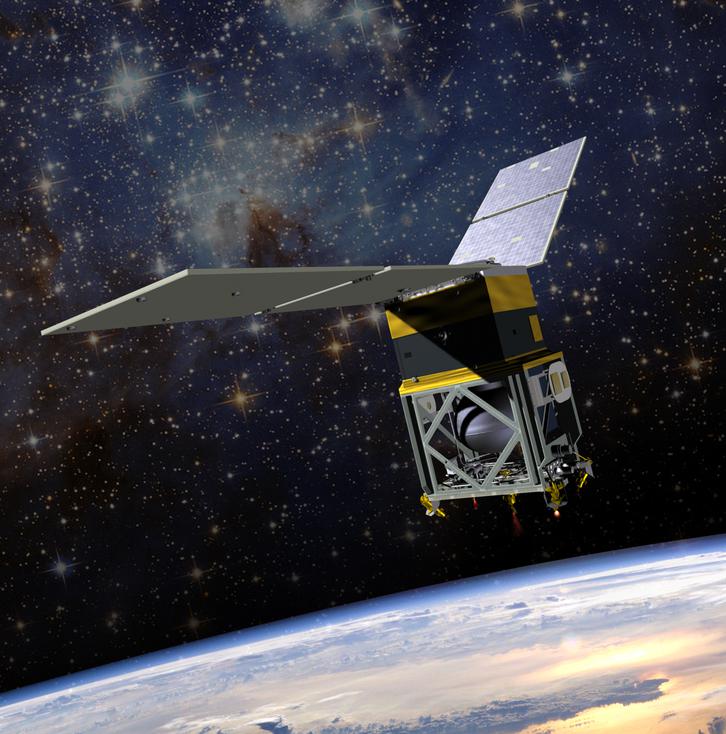The Most Massive Numbers in Existence | Live Science
That's Huge!
The 'Infinity Environment,' an installation art piece by Doug Wheeler on display at the Doug Zwirner Gallery in New York City. (Image credit: Tim Nighswander/IMAGING4ART, courtesy of David Zwirner, New York (c) 2012 Doug Wheeler)Big numbers are everywhere, from the cells in the human body to the size of the universe. But once numbers edge past the realm of the physical, the human mind can struggle to grasp the sheer awesome scale of these numbers. Even infinity can seem easier to understand in comparison — it just goes on and on. And once numbers start to get large enough, everything starts to blur together, said Jon Borwein, an applied mathematician at the University of Newcastle in Australia.
"We don't understand numbers on this scale," Borwein said.
From the humble trillion to Graham's number, here are some of the most mind-boggling numbers there are.
Big is relative
This still from an animated fly-through of the new universe map created by the Sloan Digital Sky Survey-III shows the positions of galaxies mapped in 3D space. (Image credit: Miguel A. Aragón (Johns Hopkins University), Mark SubbaRao (Adler Planetarium), Alex Szalay (Johns Hopkins University), Yushu Yao (Lawrence Berkeley National Laboratory, NERSC), and the SDSS-III Collaboration)When thinking about a personal budget, a $16 trillion debt ceiling is pretty inconceivable. But on the scale of the atoms in the universe, it looks absolutely paltry in comparison, said Scott Aaronson, a computer scientist at MIT.
To try to understand huge numbers, most people rely on analogies of scale. For instance, Carl Sagan famously likened the age of the universe to a calendar year, with humans only showing up in the last few hours of New Year's Eve.
Riemann Hypothesis
Stock market trading numbers. (Image credit: Mclek, Shutterstock)First stated in 1859, the Riemann hypothesis is one of the greatest unsolved conjectures of mathematics, and whoever solves it will nab a $1 million prize. "This is the biggest open question in mathematics, the one that will guarantee your name is known in 10,000 years," Borwein said.
The hypothesis, if true, has important implications for the distribution of prime numbers, which aren't divisible by anything other than themselves or one. To test the hypothesis, mathematicians look for extremely large primes — those bigger than about 10 raised to the power of 30, he said. That may sound abstract, but it has many real-world implications, Borwein said. "Primes are embedded in everything we use for encryption," he said. "That all relies on stuff where the algorithms are designed using properties of primes that we think are true but don't know."

The Universe
(Image credit: NASA)As far back as Archimedes, philosophers have wondered how many tiny particles could fit in the universe. Archimedes estimated that about 10 to the power of 63 grains of sand could fill the universe. He used a series of extremely rough estimates — the poppy seeds that make a grain of sand, the grains of sand that would cover the length of a stadium, and the stadia lengths between Earth and the sun, said Henry Mendell, a classical historian at California State University, Los Angeles.
Despite his crude measures, he wasn't too far off. Current estimates put the total number of atoms in the universe at about 10 to the 80.
Quantum Fudge Factor
The galaxy cluster Abell 1689 is famous for the way it bends light in a phenomenon called gravitational lensing. A new study of the cluster is revealing secrets about how dark energy shapes the universe. (Image credit: NASA, ESA, E. Jullo (JPL/LAM), P. Natarajan (Yale) and J-P. Kneib (LAM))When Einstein conceived of his equations of relativity, he included a small constant, called the cosmological constant, to account for the fact that the universe is stationary. Though he later scrapped the constant when he learned the universe is expanding, it turns out the genius may have been on to something: Scientists believe the cosmological constant, which amounts to just 10 raised to the minus 122 power, reveals clues to the dark energy that is mysteriously accelerating the universe, Aaronson said.
Hercules and the Hydra
This painted wooden weathervane was carved by Warren Gould Roby, an American coppersmith, between 1825 and 1850. Originally made for use on the roof of his own home in Massachusetts, it is now considered a classic American expression of the feminine beauty of the mermaid. (Image credit: Shelburne Museum, Shelburne, Vermont)Sometimes things have to get big before they get small. In 1982, mathematicians Jeff Paris and Laurie Kirby posed a riddle: Imagine Hercules fighting a Hydra that grows heads like a tree. If he cuts off one head, the mythic monster simply grows back a certain number of heads governed by a few rules. Amazingly, Hercules will always prevail against the Hydra eventually and chop off all of the Hydra's heads.
But even if Hercules is clever and chooses the most efficient strategy, the Hydra will first grow more than a googolplex of heads (or 10 raised to the power of 10 raised to the 100 power).
Mersenne Prime
The largest prime number has been discovered. (Image credit: Andreas Guskos | Shutterstock.com)The Mersenne Primes are a class of numbers that get big in a hurry.These prime numbers are equal to 2 raised to the power of a prime number minus 1. While the first few start out small — 3, 7, 31 — they blow up to become incredibly large extremely quickly. Until about 1951, only 12 of these primes were known, but by this year, 48 were known.
To power through these gigantic numbers, scientists use the Great Internet Mersenne Primes Search (GIMPS), which uses the computing power of thousands of Internet users to search for the elusive prime numbers. The largest known prime number, 2^57,885,161 – 1, has over 17 million digits and was discovered this year.
A Trillion Triangles
This sky map shows how Saturn, Mars and the bright star Spica will form a sky triangle on Monday night (Aug. 20, 2012). This map shows their location with the moon at 8:30 p.m. local time from mid-northern latitudes. (Image credit: Starry Night Software)Around 1000 years ago, Persian mathematician Al Karaji first asked how many congruent numbers existed. But just what are congruent numbers? The numbers are the area of right-angle triangles with integer or fraction length sides. So a triangle with sides of length of 3,4 and 5 would have an area of ½ * 3*4 = 6, making 6 a congruent number.
It took another millennia before the first hundred congruent numbers were discovered. By 2009, however supercomputers had discovered the first 3,148,379,694 congruent numbers. Some of these numbers are so enormous that if their digits were written out in decimal form, they would stretch to the moon and back. Gigantic numbers have interesting implications in data storage, because they are so huge that a stray gamma ray could disrupt the bits in these numbers and make them wrong, Borwein said.
Graham's Number
This illustration shows a black hole emitting jets of fast-moving plasma above and below it, as matter swirls around in an orbiting disk. (Image credit: NASA's Goddard Space Flight Center)All these numbers pale in comparison to Graham's number, a number so large that simply trying to remember all the digits would turn your head into a black hole. The number, which at one point was the largest number to ever be used in a math proof, arose in response to a simple riddle about how to allocate people to a certain set of committees with a few constraints.
While mathematicians are confident that at least 13 people are needed to solve the problem, in the 1970s mathematician and juggler Ronald Graham deduced that the number of people had to be lower than Graham's number. Simply computing the number would take 64 steps, and involves multiplying an insanely huge number of 3s.
There is no way to write the number out using scientific notation, and instead it must be written with a series of up-arrows that denote towers of exponents. Later on, Graham showed that the upper bound to for this riddle is much much smaller than Graham's number, but still huge.
TREE(3)
Equations aren't just useful' they're often beautiful. (Image credit: Shutterstock/Fedorov Oleksiy)While Graham's number was one of the largest numbers proposed for a specific math proof, mathematicians have gone even bigger since then. In 1998 the logician Harvey Friedman of Ohio State University proposed a riddle asking how long a sequence of letters needs to be given certain parameters of repeating stretches of letters. While the answer isn't infinite, it's absolutely massive.
The number Friedman derived, TREE(3), is calculated by creating increasingly massive towers of twos raised to the power of two using something called Ackerman functions. To give a sense of the scale, the fourth Ackerman functions involves raising two to the power of 65,536 twos. But TREE(3) is massively, massively larger than that — so massive that it makes Graham's number look like the tiniest fleck of dust in comparison.
"These higher levels of largeness blur, where one is unable to sense one level of largeness from another," Friedman wrote in his paper.
-
Latest
 PROPELLANTS - NASA
PROPELLANTS - NASA6. PROPELLANTSA. GENERAL FEATURES OF ROCKET PROPELLANTSChemical propellants in common use deliver specific impulse values ranging from about 175 up to about 300 seconds. The most energetic chemical pr...
-
Next
 Rocket Fuel (FUEL) - An Artificial Intelligence Stock? - Nanalyze
Rocket Fuel (FUEL) - An Artificial Intelligence Stock? - NanalyzeIn previous articles, we’ve talked about the merits of artificial intelligence and big data and how these technologies can enable a multitude of industries to begin learning how to do things more effe...
